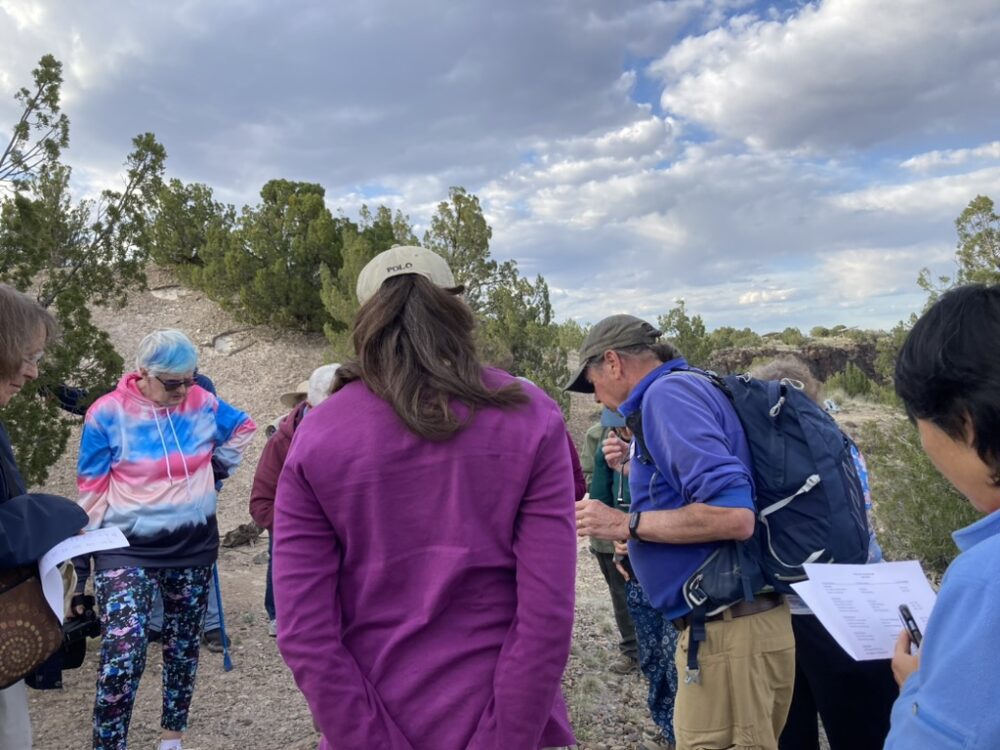
Craig Martin takes students on a wildflower hike along the canyon rim in White Rock & teaches them how to use iNaturalist May 2024 | Photo by Dana Ecelberger | Blog post by Craig Martin
Birds, butterflies, and wildflowers are all colorful, showy organisms that easily attract our attention. We organize ourselves into groups that specialize in observing, recording, and studying how these attractive life forms fit into the ecosystems where we live. But equally important, and often overlooked, are the smaller, less easily observed insects, many of whom have important ecosystem functions that include pollinating our native plants.
In addition to butterflies, moths, hummingbirds, and bats, our smaller insects, particularly bees and some types of flies, are the most efficient agents of pollination for the 1,300 species of plants we know about in the Jemez Mountains. Because there has been very little money for researching these small, native pollinators, we really don’t know that much about them: who they are, how many there are of each, what habitats they are thriving in and which they are absent from. We also don’t know much about which plants they use and what the status of those plants are in terms of being viable, threatened or endangered. Because of the lack of funding to conduct this important research, Citizen Science is critical because it allows us to gather vital information at little to no cost, and on a very broad scale.
To help fill the gap on the Pajarito Plateau, PEEC and Bee City Los Alamos have created an iNaturalist project designed to create an inventory of pollinators and native plants in Los Alamos County. An iNaturalist project is simply a method of crowd-sourcing and collecting observations of plants and animals in a specific area and organizing them into a visual database that allows open access to anyone who uses the free iNaturalist app on their phone and/or computer or tablet. The project began on Earth Day (about a month ago) and so far has assembled 1,115 observations of 315 species by 62 observers. Seventy-six of the observations are of pollinators.
While the Jemez Mountain Herbarium has a pretty good handle on the plant species of Los Alamos County, not much work has been done on pollinators. This project hopes to record bees, butterflies, moths, flies, and other insects and birds that visit flowers throughout the growing season. It will also provide a day-to-day list of what is blooming in Los Alamos, in real time.
An observation in iNaturalist mainly consists of a photo of the organism being observed–usually a phone photo and the attached GPS coordinates. If you know what it is, or think you have a pretty good idea, then you can identify the organism. If you have no idea or are unsure, you can let iNaturalist take a guess on the ID, or another iNaturalist user will chime in with an ID.
If you already use iNaturalist then your observations from within Los Alamos will automatically be included in the project–no need to do anything special. If you are interested in participating but don’t know how to use iNaturalist, you will have to set up a free iNaturalist account, which is easiest to do on a computer—then you can download the app onto your phone.
If you want to check out the project, follow this link:
https://www.inaturalist.org/projects/native-plants-and-pollinators-in-los-alamos-county
If you need help getting started with iNaturalist, send me an email and we can arrange a 30-minute lesson at PEEC and I’ll teach you.
Email me with any questions at: bikeandhikenm@gmail.com
